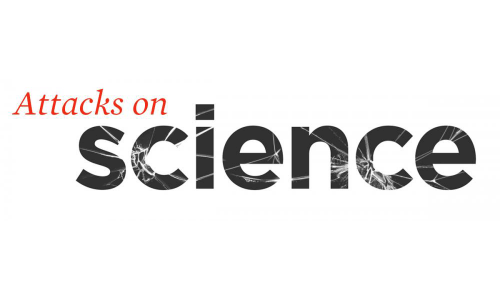Infectious disease epidemiologist Dr. Beth Linas discusses how we move forward after flattening the curve of the coronavirus.
In this episode
- We continue our coverage of the COVID-19 pandemic
- Beth Linas explains herd immunity, contact tracing and more
- Colleen tries to figure out what happens after we flatten the curve? What comes next?
Timing and cues
Opener (0:00-0:31)
Intro (0:31-2:31)
Interview part 1(2:31-11:59)
Break (11:59-13:28)
Interview part 2 (13:28-24:39)
This Week in Science History Throw (24:39-24:45)
This Week in Science History (24:45-27:25)
Outro (27:25-28:30)
Related content
Show credits
This Week in Science History: Katy Love
Editing: Omari Spears
Music: Brian Middleton
Research and writing: Jiayu Liang and Pamela Worth
Executive producer: Rich Hayes
Host: Colleen MacDonald
Full transcript
Good news, listeners. I finally found the corner of my house that looks best for professional video calls. It was a much appreciated victory after a long struggle to replace my lost cellphone, which would’ve been frustrating even before I started wearing a mask, staying 6 feet away from everyone at the store, and regarding any object outside my home with suspicion.
So as the coronavirus continues pushing our daily lives into new and stressful territory, I want to talk about one of the holy grails in the fight against COVID-19 –herd immunity – and how we can emerge from our homes in a way that’s safe for ourselves, our families, and our communities.
In a previous episode of the Got Science? Podcast, we learned from immunology expert Dr. Welsch that it will likely be over a year before we see a coronavirus vaccine. So what’s the plan until then? How can we safely leave our self-contained bubbles before a vaccine is available?
Unsurprisingly, the answer is complicated, especially when new information comes in almost every hour. To understand all the variables that experts need to study and consider, I decided to speak to one directly. Our guest today is Dr. Beth Linas, an infectious disease epidemiologist who’s passionate about using data to inform public health policy. She talks about the unique challenges of trying to contain a novel virus—aka, the reasons we have to treat this so differently from the seasonal flu, and explains why it’s still too soon to go back to our offices, even though the curve has flattened. And she gives us an important crash course on how diseases move through communities, how contact tracing works, and how we hope to achieve herd immunity and protect everyone.
Colleen: Beth, welcome to the podcast.
Beth: Thanks for having me.
Colleen: So, we've been hearing a lot recently about herd immunity. And I do wanna get to that and some other topics. But first, can you just give us a basic understanding of how our bodies develop immunity to a virus?
Beth: Sure. Viruses, like other pathogens, bacteria, for example, don't produce symptoms as soon as you come into contact with them. So what happens is, they come through your body, in this case probably through your nose, mouth, or eyes, and there's an incubation period. And an incubation period is a time where the virus multiplies to a threshold necessary to produce symptoms. And at the same time, during that period, your body, the immune system recognizes the virus and reacts through a couple of different immune responses. So, it produces specific cells that can then release specific antibodies to fight infection. And so, if your immune system can keep the virus population in your body below a certain threshold, you might not experience symptoms, but you can still spread the virus as we know in COVID. Every individual's immune system is different and how it works, and produces these antibodies.
Colleen: If I get COVID-19, and I recover, am I then immune?
Beth: You know, so that's a good question. We're not 100% sure. Generally, we expect for people to be immune initially because you have produced antibodies to COVID. Now viruses, and viruses like COVID are RNA viruses, like the flu and HIV, and they are known to mutate. But it's not clear how or if or when COVID will mutate. And so, there is an expectation of some sort of immunity. We don't know for how long. But that's sort of the prevailing thought at the moment. I think Dr. Fauci spoke about this as well. But generally speaking, we have to get a flu shot every year because the flu, it mutates and so they make a new vaccine every year. But we know that you have some sort of immunity, we're just not sure how much and for how long.
Colleen: So, then what is herd immunity?
Beth: So herd immunity is this concept that at a very basic level, if enough people are immune, you yourself could be protected if you weren't to have a vaccine, for example. So, it is sort of an indirect form of protection. It requires a large percentage of the population to be immune. And with that immunity at a population level, the virus can't effectively move between people. And so, that's why it's so important when the flu vaccine comes up... Each year we have a flu shot, we want as many people as we can to get the vaccine so they're immune because we know some people can't get a vaccine and other people, they're just immunocompromised. We wanna be able to protect everyone. And so, that herd immunity allows us to attempt to do that so that if something does come into our communities, it doesn't have enough susceptible people or people who are not protected to infect.
And so, we don't have a good sense at the moment how many people in our country would need to be immune. I've been reading that prevailing thoughts are nearly 80% of our population would need to be immune. And it's tough because this is a completely novel virus. So, no one has seen it before. So, every single person was susceptible. With other viruses, that's not necessarily the case. It's a little more complicated to do the calculations. So you know, the flu changes and some people have immunity and doesn't. But this virus, everyone is susceptible, which is why at the moment, we're seeing such large numbers of infection and such high numbers of, sadly, death.
Colleen: So to get to the percentage of the population being immune, is that mainly through a vaccine or a combination of people gaining immunity through being exposed to it?
Beth: So, generally, we don't want anyone to become exposed and ill to get immunity. We don't know if someone might succumb to the disease, right? And we can do it in a very controlled fashion by using a vaccine, right? We can implement it and make sure...and then we can know exactly who had the vaccine and who didn't. And so, generally speaking, vaccination is the best way for us to sort of control and develop this herd immunity. Now, we know people, not everyone will get vaccinated for a variety of reasons, and at the moment, we don't have a vaccine, right? So, at the moment, we know people who got COVID and recovered, we expect them to be immune. And then hopefully, eventually we'll have a vaccine and so there will be a combination of those who are vaccinated, and those who have, become sick and recovered to help get that herd immunity.
Colleen: I'm assuming a vaccine is going to be probably 12 months minimum to be developed and then it has to be deployed. What do we do between now and then? How do we manage this virus?
Beth: Yeah, so this is the million-dollar question right now. Right? In epidemiology, we have some very basic tools in a toolbox that we know work, but they're laborious and some people think cumbersome. But this physical distancing is really effective. The virus can't go places if people aren't moving. And so, the physical distancing is one of our main tools. The other tools that we have are, I'm sure people have heard of contact tracing, and isolation, and quarantine. And those are other tools we use to detect and find people who are sick, and keep them at a physical distance until they've recovered and also keep people who haven't become sick, also separated from those who may or may not have symptoms.
Colleen: So, give me a definition of those because I suspect a lot of people might not be familiar with those tools.
Beth: Generally speaking, isolation is when we separate sick people with contagious diseases from people who are not sick so they can recover. Quarantine separates and restricts the movement of people who are exposed to a contagious disease to see if they become sick. They may have been exposed to a disease and don't know it or they may have the disease and not show symptoms. So, for example, right now, I'm just social distancing, I haven't, to my knowledge, been exposed. And so, I keep on social distancing. For example, if I was still working in my office, and someone became sick, that person would then be put in isolation, and myself if I had been in sustained contact with them, which we know close contact is, within the CDC suggest six feet for a little bit of time, so more than a second, maybe 5 to 10 minutes, I would then be put in quarantine to see if I get sick. But the idea is if I were to come home and my partner who hadn't at that moment been exposed, well, they would have to be put in quarantine as well. So, for me, it's not terribly difficult because I don't have children and my partner would be A-okay. But when you think about families, it's really not sustainable or feasible or right to separate parents and children. You can't really do that. So, that's the tricky part between quarantine and isolation and contact tracing, that sort of, in our country we're sort of grappling with.
Colleen: Contact tracing seems really difficult to me. I mean, I'm assuming that means, if somebody has it, you have to figure out how many people they've come into contact with, and for how long, and then how many people they've come into contact with?
Beth: It's difficult in the sense that it takes a lot of people and probably people hours, but the basic concept is what you just described, which is, you try to speak to the individual who is sick, they typically say...at that moment, they call that person, the index case, and you try to learn where they have been and who they've been in contact with, and then go speak to those individuals, and do the same thing. And it allows you to create sort of this map if you can imagine a map of movement, and you can see where people who have come into contact. And then you're also trying to figure out where that index case was infected. So, initially, in Seattle, and before community spread was happening, we knew a lot of the cases, the initial cases were coming from people who traveled from China. They were in China, they came back to America. So, that index was pretty straightforward. It does become more difficult when you have community spread and community transmission because you're piecing together who went where, but it's very effective because you sort of deploy other people, it takes many people to do this and then you isolate and quarantine, isolate and quarantine, and you keep following up with those individuals about their symptoms and how they're feeling. You could do it over the phone. And, you know, now we're trying to determine if we could do it digitally. And it's laborious, but it's easier than trying to figure out a vaccine at the moment, right? Like, this is the tool we have. You know, vaccines have to go through trials and there's a lot that has to happen with a vaccine. So, this is really just the upfront tool we have right now.
[Break]
Colleen: So would the CDC be in charge of managing contact tracing?
Beth: In our country, we have reportable diseases that are mandated if you find a patient that has an infection, that you report to the local health department. The flu is one of them, obviously, but then several STDs, measles, mumps. And the reason why we have that so if there are cases, we go out and we start contact tracing and we start interviewing people. Now, something like an STD is a little bit easier to contact trace because we know exactly how one becomes infected. Right? And so, we know that if Joe was in a coffee shop and had gonorrhea, no one in the shop would have gonorrhea. We wouldn't have to worry about that. We know that it's transmitted through sexual activity. So, we would speak to Joe about his sexual contacts. Now, that's hard because some people don't wanna talk about it, but we know that that's how we contact trace. In this case, COVID, would be reported to the local health department and they can go out, and talk to those individuals, but this transmission is different. And also we know that everyone's susceptible. So, the local health department really is responsible for that but quickly, we became overwhelmed with case.
Now that we're coming to a different part in some cities, so I don't know if New York's there yet, but we'll just use it as an example that they could possibly start going back and then contact trace. And then it could be coordinated through the federal government through the CDC because this is a pandemic, this is not a localized outbreak, right? It's not happening in one place. But really, we've never sort of done contact tracing at this scale so it's tricky. And so, that's why people are very interested in using these digital technologies to be able to do it.
Colleen: Right. What are epidemiologists specifically focusing on?
Beth: For me, my background as an epidemiologist in infectious disease is looking at people at risk for certain infectious diseases. So, my previous research and work was all about looking at people who inject drugs and their risk for infection of a variety of different viruses, HIV, hepatitis. So for me, I'm really interested in populations of who are getting sick and why, and understanding how we could help them. So, sadly, we're seeing already this disparity that's occurring for African American individuals and Hispanics, that they're becoming sick at higher rates and succumbing at higher rates than others. And we have a pretty good thought as to why on the social side. So, some of these individuals are most likely essential health workers or essential employees, and they can't stay at home, and they can't socially distance, they have to work. They might also live in more dense and crowded housing locations with multiple generations of individuals. So, we know that's a problem. And they may or may not have access to primary care to be able to talk to a doctor before they get ill, and then they end up having to go right to the emergency room.
So I'm really interested in looking at who, and where, and why people are getting sick, and trying to mitigate that impact to prevent. Other things that epidemiologists are interested in would be, you know, how do we do this testing, and tracing, and isolation type activity, and others might be really interested to understand why children seem at the moment to be spared and/or infected or not infected. We don't really know actually what's going on with children. It is super interesting. And then others are really gonna be looking at sort of this mass vaccination and/or antibody testing, and what does that look like?
Colleen: I believe the CDC has said that up to 25 percent of the country might be infected without symptoms.
Beth: Yeah, so that actually goes back to the issue of herd immunity, and isolation, and contract tracing because we have now realized and I think Dr. Redfield at the CDC had quoted up to 25 percent of the population might be infected without symptoms. Either they're pre-symptomatic or they're asymptomatic, which are slightly different. The prevailing thought from sort of the Infectious Disease Society of America suggests it's probably pre-symptomatic, but we don't know. The reason why we wanna test is because if people have antibodies and they might be immune, then we'd be able to...you know, those individuals could ostensibly be more frontline or go about their day-to-day, for example. If they're not and they're totally susceptible, and they have no exposure, they haven't had any known exposure, then we don't wanna put more people at risk. And so, we're trying to get a sense of where people in the infection, if you will, so that we can in a more educated way, understand how we can reopen, society if you will.
Colleen: That means you would be testing people who are asymptomatic?
Beth: In an ideal world, we would test everybody. We don't have the ability to do that. There's questions with free agents.... There’s questions with... some now are questioning whether the tests are, I don't wanna say accurate, but there's some questions about false negatives or false positives, I guess more on the false-negative side. And we haven't gotten a really good serology test to look for those antibodies. There was a case study or example in California looking at an antibody test. But that was only in one location. We haven't really nailed down that antibody test, to my knowledge. I could be wrong at this moment. You know, the information changes by the hour, almost by the hour, it feels like. But the idea would be to understand who could go back to work and who could be in other populations without concern of reigniting a big spread.
Colleen: So have scientists come up with a plan for how we get back to everyday life?
Beth: Dr. Scott Gottlieb, who was the former FDA Commissioner, worked with Hopkins and other leading scientists to put out a roadmap at the WHO put out a road map that said, sustained transmission needs to come down. And to do that, we have to understand who's sick so we have to test. And it's also a measurable thing we can do. We can say, "Okay, this community, where there's been a very high burden of disease, we've tested, it might be a weighted sample. We can't test everyone. Do we test 50%? Do we test 20%?" Those are numbers that have to be calculated to understand how we could then ensure we understand the spread of the disease in that community. But, ideally, we would test everyone.
Colleen: Ideally, we would test everyone. Is that feasible? And if it is, how quickly could we do that?
Beth: So, the feasibility question, it has a lot of components to it. So, do we have enough tests? Are there enough free agents for the test? How fast can we turn around the tests? In terms of doing the testing, and this is just my opinion, I just need to put it out there, it's not something that anyone's doing or could do but the federal government could partner with private companies. They had drive-thru testing. I'm sorry, we did the testing, you know, drive-thru, we could do that again. And we could scale it. I think that could be feasible.
Colleen: So, right. We have options or we can think of creative ways to be able to administer the test, but we need to have the test, the physical test.
Beth: Right. You know, and then we need people willing to come out and get tested. There are a lot of, for a variety of reasons why people might not wanna get tested. You know, stigma being one of them or fear of losing a job. We have to sort of socialize that and make people realize, it's about everybody and not just yourself. And so, you'd have to work on that. But I think it could be really powerful because we could understand, who and where people are more impacted than not, and then work with communities to determine the best way forward and the best path forward for going back to work,...
Colleen: So, for people who are thinking, "Okay. It's been a month plus that we've been self-isolating, the curve has flattened, I'm ready to get back out there," what would you tell them?
Beth: I would just tell them that if everyone did that at the same time and we don't know who's sick, we would definitely see increases in cases. If we go back too soon, we're gonna be put back where we were at the beginning. And so, it's really difficult for people who aren't concerned or don't understand why this virus impacts them because no one around them is sick or they're young or they're healthy, they wanna go back to work. But the truth is, is that everyone is at risk. And so, the physical distancing right now is our best path forward and then testing. And without those things, we're gonna back to where we were at the very beginning.
Colleen: Nobody really knows if we are going to see a second wave, but it seems likely. What are your thoughts on that?
Beth: I think there is going to be a low level of COVID spread, from here on out, the way the flu spreads. It's an RNA virus. We know it mutates. I think COVID would possibly be like that. And I think our goal is we don't want it to be worse than that. And so, we could get to a point where there are lower levels of infection and hospitalizations. And if we do it correctly, we can get it to a low level that's, I guess, more tolerable, and we could go on with our daily lives. But if we don't do that well, if we open up too early and there's still too much community spread occurring, then I believe there could be a second wave but I don't know when and I don't know how strong of a second wave it would be because we don't know how long people are immune. When, people are susceptible to begin with and then they become infected, at this point, many thousands of people have been infected. So, there's some sort of immunity there. So a second wave possibly wouldn't be as big, but we don't know. It could be, if we just went fully back to normal life and everyone went back to their concerts and airplane travel. I think there's gonna be underlying spread. I don’t really have a good sense of what a second wave would look like in our country.
Colleen: What is the one thing you'd really like people to understand about this virus?
Beth: I think it's really tough for people to understand that, just because you're healthy today or you're going about your day, you know, and you may or may not have been exposed, two weeks from now, you might be sick. And I think that's scary. Personally, I try not to think about it.
Colleen: It is scary. But I’m just so glad there are experts like you helping us to understand the facts during these challenging times. Beth, thank you so much for joining me.
Beth: Thank you so much for having me.



